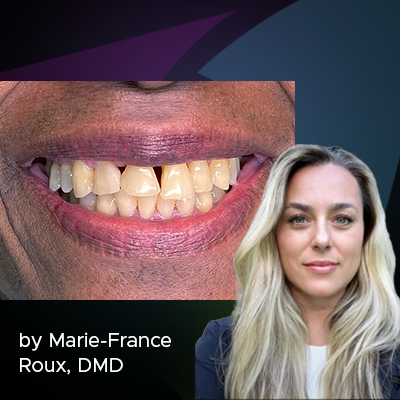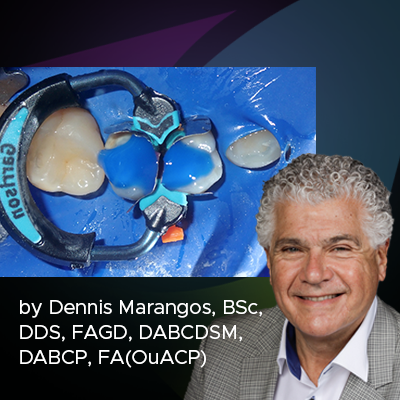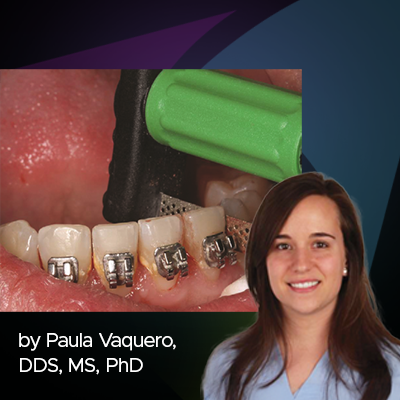
Ask the Expert: An Interview with Nate Lawson, DMD, PhD on Sectional Matrix Systems
What is the advantage of using sectional matrices over circumferential matrices for composite restorations?
A circumferential matrix placed in a Tofflemire retainer is necessary for placing an amalgam restoration. The reason is that amalgam is forcefully condensed against the matrix band and it needs to maintain a tight seal against the tooth. With direct composite restorations, the composite material is no longer forcibly condensed against the matrix. Rather it is flowed or packed into the tooth preparation. There are several advantages of using sectional matrices. First, sectional matrix bands provide more incisal-gingival contour than flat circumferential matrix bands. Second, a sectional matrix is often easier to place on a two-surface preparation than a circumferential band because the circumferential band must pass through the unbroken contact on the opposite side of the tooth. Third, the use of a separating ring with a sectional matrix leads to a stronger, consistent contact than the use of a circumferential band and a wooden wedge.
How do the DualForce™ Ultra-Wrap™ Matrix Bands compare to other sectional matrix bands?
The DualForce Ultra-Wrap Matrix Bandhas an anatomical contour that differentiates it from earlier bean-shaped sectional matrices. The matrix has a lip on the occlusal edge of the band that helps to form the occlusal embrasure. Additionally, the matrix has a gingival apron (that can be trimmed) that extends gingival beyond the bottom of the box to help adapt the matrix to the tooth while still forming a cleansable emergence profile. The matrix has a U-shaped contour in the buccal-lingual direction that helps to produce a wide buccal-lingual contact. The thickness of the matrix is about 35 microns, however, it is not dead soft. The firmness of the matrix helps to prevent crimping when inserting the matrix and deformation while adjusting the matrix.
How do you pick the correct size of Ultra-Wrap Matrix Band?
If the matrix is too big or small, it will affect the incisal-gingival location of the contact point and complicate sculpting of the uncured composite. The matrix should extend slightly gingival to the bottom of the box and about 0.5 mm occlusal of the adjacent marginal ridge. Therefore, the clinician may measure the distance from the bottom of the box to the height of the adjacent marginal ridge with a periodontal probe, and a matrix should be chosen to be about 1 mm taller than that distance. This will allow the matrix to extend beyond the bottom of the box and slightly above the adjacent marginal ridge.
What are some of the features of the DualForce Active-Wedge™ that differentiate this tool?
With two pounds of separating force provided by a separating ring, it is no longer necessary for a wedge to provide the primary source of separation. The major function of a wedge is to seal the gingival box. TheDualForce Active-Wedge is an anatomically contoured wedge. Unlike a traditional wooden wedge, the DualForce Active-Wedge is wider in the mesial-distal dimension on either side of the contact point. It is hollow so that its tip can be passed through the contact point and then automatically expands on the other side. Also the wedge is shorter incisal-gingival at the contact point than on either side of the contact point. Therefore, this geometry prevents the wedge from encroaching into the contact area.
From which direction should the wedge be placed?
The wedge should be placed from the direction of the larger embrasure. Typically this will be the lingual embrasure; however, it may be more beneficial to place the wedge from the side of the tooth (relative to the contact point) that has received more preparation. If more of the buccal aspect of the tooth was prepared than the lingual aspect, the wedge would serve more benefit by adapting the matrix to the buccal aspect.
How does the DualForce Ring compare to other separating rings?
We have compared the separating force produced by several popular separating rings. The rings were tested by connecting the opposite ends of two adjacent typodont teeth (mesial of 1st premolar and distal of 2nd premolar) to a load sensor. Different rings were placed on the premolars and the force placed on the load sensor was recorded. The DualForce Ring recorded the highest separating force of any ring tested. This separating force may be attributed to the two independent rings. Additionally the contour of the feet allow tight adaptation of the matrix to the buccal and lingual walls of the preparation to prevent excess composite flash.
How do you manage side-by-side Class II restorations?
Side-by-side Class II preparations present an additional clinical challenge as the space between the two teeth must be properly allocated and if restored at the same time, the thickness of two matrix bands must be compensated for. A predictable but less efficient method is to restore the teeth individually. This offers the advantage of allowing adjustment of the first restoration and only using one band for the final restoration. If both restorations are attempted at the same time, the powerful separation force of the DualForce Ring may help compensate for the thickness of two bands.
About the Author

Nate Lawson, DMD, PhD
Nate Lawson DMD, PhD is the Director of the Division of Biomaterials at the University of Alabama at Birmingham School of Dentistry and the program director of the Biomaterials residency program. He graduated from UAB School of Dentistry in 2011 and obtained his PhD in Biomedical Engineering in 2012. His research interests are the mechanical, optical, and biologic properties of dental materials and clinical evaluation of new dental materials. He was the 2016 recipient of the Stanford New Investigator Award and the 2017 3M Innovative Research Fellowship both from the American Dental Association. He served on the American Dental Association Council of Scientific Affairs and is on the editorial board of The Journal of Adhesive Dentistry and Compendium. He has lectured nationally and internationally on the subject of dental materials. He also works as a general dentist in the UAB Faculty Practice.
Discover More
This article was originally published in the Clinical Life™ magazine: Fall 2021 edition
Clinical Life™ magazine is a premier periodical publication by Clinical Research Dental Supplies & Services Inc. Discover compelling clinical cases from Canadian and US dental professionals, cutting-edge techniques, product insights, and continuing education events.
Subscribe to our emails to receive articles like this and be notified about our exclusive promotions.




